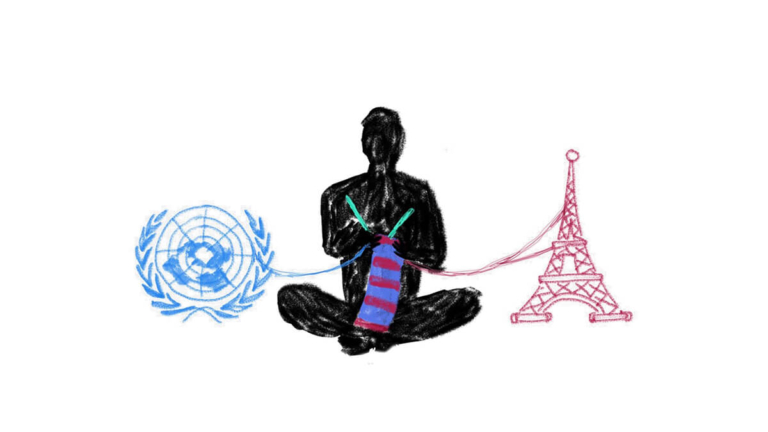Casebook Info
In the fall of 2020, six Portuguese children and young adults filed a petition with the European Court of Human Rights (ECtHR) against thirty-three European countries, arguing that the respondent countries’ failure to adequately address climate change as well as their own contributions to it violated the young people’s rights guaranteed under the European Convention on Human Rights. The plaintiffs advance important legal arguments, which – if accepted by the Court – have the potential to bolster litigation both in Europe and around the world. The case is currently pending before the Court.
- Year Filed 2020
- Year of Most Recent Ruling N/A
- Year of Final Ruling N/A
- Jurisdiction Regional (Europe)
- Court Name European Court of Human Rights
- Primary Focus Mitigation
- Ruling On N/A
- Plaintiff(s) Six Portuguese children & young adults
- Respondent(s) thirty-three European countries
- Outcome Pending
- Organizational leader of the litigation Global Legal Action Network (GLAN)
Background
In the fall of 2020, six Portuguese children and young adults filed a petition with the European Court of Human Rights (ECtHR) against thirty-three European countries, arguing that the respondent countries’ failure to adequately address climate change as well as their own contributions to it violated the young people’s rights guaranteed under the European Convention on Human Rights.
“The respective independent contributions of multiple states to environmental harm, in breach of each state’s international obligations, give rise to shared responsibility for that harm. The relevant international obligations are the duties under Articles 2, 8, and 14 [of the European Convention on Human Rights] . . . The Respondents must be presumed to share responsibility under the Convention for the interferences to the Applicants’ rights caused by climate change.”
Petition Annex
In some ways, this case is quite like other rights-based climate cases that have been filed around the world. In essence, this petition argues that the climate change impacts that will result from the current trajectory of greenhouse gas (GHG) emissions violates the petitioners’ rights to life and respect for private and family life. This parallels other climate cases – like Amazon’s Future Generations v. Ministry of Environment and Juliana v. United States – which argue that countries’ actions contributing to climate change – or countries’ failures to address climate change – violate protected human and constitutional rights.
In several important ways, however, this case stands out. And because of these particular features, the case may solidify new legal norms and doctrines that could accelerate the impact of rights-based climate litigation and spur more effective action on climate change. Importantly, this case was filed, in substantial part, to take advantage of the regional authority of the ECtHR. If the young petitioners succeed in obtaining the judgment they want, it would obligate the respondent countries to pursue GHG emission reductions that would be collectively consistent with limiting global warming to well below two degrees Celsius. In this way, it would help enforce the goal of the Paris Agreement (limiting warming to well below two degrees Celsius and working to limit it to 1.5 degrees Celsius) while providing the teeth that the Paris Agreement lacks (countries’ specific commitments to reduce GHG emissions under the Paris Agreement are not binding).
“[I]t is more appropriate that the Respondents rather than the Applicants bear the consequences of the absence of a clearly defined approach to global burden-sharing. The ambiguity surrounding the nature of a state’s ‘fair share’ is a direct consequence of the failure by states (globally) to agree a clearly defined approach to sharing the burden of mitigating climate change. Burden-sharing is, by definition, a matter for states, including the Respondents, to resolve between themselves rather than a matter arising as between the Applicants (or victims of climate change generally) and the Respondents (or states generally).”
Petition Annex
Because the Paris Agreement contains an overarching goal to limit the average temperature increase of the planet but does not include a method to distribute responsibilities for reducing specific quantities of emissions, countries can commit to reducing quantities of emissions that collectively – when all countries’ commitments are tallied – will fail to limit warming to well below two degrees Celsius. The judgment sought in this case would help undercut that impulse by requiring each respondent to do their “fair share” of emissions reductions, which, by definition, would have to be collectively consistent with the Paris temperature goal if other countries pursued similarly ambitious reductions.
If the case achieves what the petitioners hope it does, it may accelerate the adoption of more ambitious climate policies across Europe, with reverberations felt around the world.
- 33 The number of European countries named as respondents in this case
- 11,000+ The number of scientists who released a statement in November 2019 collectively declaring “clearly and unequivocally that planet Earth is facing a climate emergency”
- 120 The number of lives lost in record-breaking, extreme wildfires in Portugal in 2017
- Arts. 2, 8, & 14 The Articles of the European Convention on Human Rights the youth plaintiffs allege the respondent countries have violated by contributing to / failing to act to stem climate change
Strategies
Providing an inclusive definition of the greenhouse gas emissions for which countries / corporations are responsible

The petitioners argue that the respondent countries are responsible for contributing to climate change by (1) permitting the release of greenhouse gas (GHG) emissions within their territories and areas they control; (2) allowing the export of fossil fuels extracted from within their territories; (3) permitting the import of goods whose production results in the release of GHG emissions; and (4) allowing “entities within their [territories] to contribute to the release of emissions overseas, e.g. through their extraction of fossil fuels overseas or by financing such extractions.”
This is an inclusive framing of the GHG emissions for which countries are responsible, as opposed to a narrower framing which may only include those GHG emissions released within a given country’s territorial boundaries. This wider framing is important because it addresses the way in which countries, especially developed countries, offload emissions onto other countries by importing carbon-intensive goods from abroad. Moreover, by including the extraction of fossil fuels within a country’s boundaries, the petitioners seek to prevent countries from evading responsibility for supplying the fossil fuels driving the climate emergency.
Tying countries’ / corporations’ climate and human rights obligations to international climate and environmental law, including, for example, the temperature target established by the Paris Agreement

Here, the petitioners argue that the content of countries’ obligations under the European Convention on Human Rights should take into account relevant international environmental and climate principles. This includes the provision of the Paris Agreement underscoring the need to limit global warming to 1.5 degrees Celsius in order to prevent “significant deleterious effects. . . on human health and welfare” (Paris Agreement Art. 2(a); UNFCCC Arts. 1(1), 3). It also includes the obligation to consider the best interests of the child under the UN Convention on the Rights of the Child, the principle of intergenerational equity found in the Rio Declaration and the UN Framework Convention on Climate Change, and the precautionary principle.
Affirming country / corporate responsibility for their ‘fair share’ of emission reductions, regardless of the actions of other countries or corporations.

Countries often try to avoid taking sufficiently ambitious emission reductions by arguing either that (1) they can’t be required to take more ambitious action because their actions alone won’t stop the climate crisis, or (2) that there is no internationally agreed upon method to divide up specific quantities of greenhouse gases, so the court can’t mandate one.
The petition responds preemptively to these potential arguments. The petitioners argue that the respondent countries are responsible for violations of rights stemming from their own contributions to climate change because there is no requirement under the case law that the petitioners prove that ‘but for’ the respondent countries’ contributions to climate change, the impacts would not occur. Moreover, countries can share responsibility for acts that violate a legal obligation when those actions together create an indivisible – meaning “impossible to divide or separate” – injury. Here, since the respondent countries each contribute to climate change, they can be held responsible for the indivisible injuries generated by climate change that the petitioners experience.
Regarding the lack of a methodology to divvy up quantities of greenhouse gas emissions, the petitioners argue first that a country’s fair share must contribute to the collective achievement of the Paris temperature goal. From there, they say that – in the absence of a precise method to divide emissions consistently with the collective temperature goal – the respondent countries should bear the consequences, not the petitioners. That, according to the petitioners, should be the way to proceed both because the lack of such a method is a direct consequence of countries’ failure to agree on such a method and because the sharing of emission reduction burdens is a matter for countries to resolve among themselves and not with the petitioners.
Shifting the presumption of proving the adequacy of the countries’ / corporations’ climate actions to the respondent countries / corporations

Petitioners in climate cases sometimes struggle to provide an appropriate method to prove that a given country’s climate actions are inadequate.
Here, the petitioners offer a way around this. They point to a general principle of law that provides “that where one or more of a number of potential wrongdoers must have caused a particular harm, but there is uncertainty as to which of them in fact caused that harm, then each of those potential wrongdoers is presumptively responsible in law for the harm in question, such that the onus is on those potential wrongdoers to show that they did not cause it.”
This applies in this case because there is a harm – the climate harms the petitioners experience – and multiple potential wrongdoers – the respondent countries who have released emissions or otherwise contributed to climate change – but uncertainty as to whether a specific respondent country’s emissions caused a specific harm that the petitioners experience. As a result, the onus here should be, according to the petitioners, on the respondent countries to prove they did not cause the harms at issue – or, in other words, to prove that their climate policies and the emission reductions they have committed to achieve are adequate.
Emphasizing the urgency of taking climate action now, given the compounding and permanent effects of climate change as time progresses

The fact that carbon dioxide emissions, once emitted, are permanent over human timescales (since they remain in the atmosphere for hundreds of years) and that the impacts of climate change are compounding and accelerate over time should be taken into consideration when assessing a climate case, as various litigators and courts have argued.
Here, the petitioners assert that the urgency of climate change – and the need to act now in order to prevent compounding and accelerating effects – means that they should not be expected to litigate in the domestic courts of each respondent country before bringing the case before the European Court of Human Rights. More specifically, because there is an extremely limited amount of time left for countries to take the mitigating measures necessary to prevent warming above 1.5 degrees Celsius, the need to expedite processes is substantial, and a judgment by the ECtHR would vastly increase the likelihood that litigation before individual national courts would be resolved in a timely manner.

